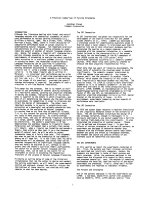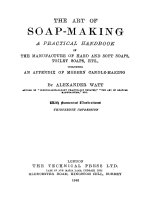A practical handbook of preparative HPLC
Bạn đang xem bản rút gọn của tài liệu. Xem và tải ngay bản đầy đủ của tài liệu tại đây (1.13 MB, 193 trang )
www.pdfgrip.com
A Practical
Handbook of
Preparative HPLC
www.pdfgrip.com
Don Wellings is the Chief Scientific Officer
for Chromatide Ltd, a company specializing
in contract purification and consultancy
services. Don has been performing preparative chromatographic separations since his
PhD where he was routinely running 10 cm
diameter columns more than 20 years ago.
The wealth of knowledge accumulated over
the successive years has been as broad as it is deep.
Prior to setting up Chromatide with an ex-colleague from
Avecia, he was Technology Manager for Special Projects at
Polymer Laboratories, where he was intimately involved in the
design and development of new polymeric stationary phases
for reversed phase, normal phase, ion-exchange, affinity and
chiral HPLC. Previously Don was Technology Manager for
Separation Sciences and Solid Phase Organic Chemistry at
Avecia. During this period he developed an expertise applying
molecular modeling to the design of chiral ligands for preparative chromatography.
In the late 1990s he was involved in the installation and commissioning of process scale HPLC at Zeneca Pharmaceuticals.
During 18 years with CRB, ICI, Zeneca and Avecia he was
instrumental in establishing the technique of preparative
HPLC within the company and served 11 years as the secretary
of the company’s Process Scale Chromatography Group.
www.pdfgrip.com
A Practical
Handbook of
Preparative HPLC
Dr. Donald A. Wellings
• BOSTON • HEIDELBERG • LONDON • NEW YORK •
OXFORD • PARIS • SAN DIEGO • SINGAPORE • SYDNEY • TOKYO
AMSTERDAM
www.pdfgrip.com
Elsevier
The Boulevard, Langford Lane, Kidlington, Oxford, OX5 1GB, UK
Radarweg 29, PO Box 211, 1000 AE Amsterdam, The Netherlands
Copy © 2006 Elsevier Ltd. All rights reserved
The right of Don Wellings to be identified as the author of this work has been asserted in
accordance with the Copyright, Designs and Patents Act 1988
No part of this publication may be reproduced, stored in a retrieval system or transmitted
in any form or by any means electronic, mechanical, photocopying, recording or otherwise
without the prior written permission of the publisher
Permission may be sought directly from Elsevier’s Science & Technology Rights
Department in Oxford, UK: phone: (ϩ44) (0) 1865 843830; fax: (ϩ44) (0) 1865 853333;
email: Alternatively you can submit your request online by
visiting the Elsevier web site at and selecting
Obtaining permission to use Elsevier material
Notice
No responsibility is assumed by the publisher for any injury and/or damage to persons or
property as a matter of products liability, negligence or otherwise, or from any use or
operation of any methods, products, instructions or ideas contained in the material herein.
Because of rapid advances in the medical sciences, in particular, independent verification
of diagnoses and drug dosages should be made
British Library Cataloguing in Publication Data
Wellings, Donald A.
A practical handbook of preparative HPLC
1. High performance liquid chromatography
I. Title
543.8Ј4
Library of Congress Cataloging-in-Publication Data
A catalog record for this book is available from the Library of Congress
ISBN 13: 978-1-8-56-17466-4
ISBN 10: 1-8-56-17466-2
Typeset by Charon Tec Ltd, Chennai, India
www.charontec.com
Printed and bound in Italy
06 07 08 09 10
10 9 8 7 6 5 4 3 2 1
www.pdfgrip.com
Contents
Preface
Foreword
Abbreviations
vii
ix
xi
1 The history and development of preparative
HPLC
1
2 Fluid dynamics, mass transport and friction
17
3 Modes of chromatographic separation
Particle size
Pore structure, size and surface area
3.1 Normal phase chromatography
3.2 Reversed phase chromatography
3.3 Chiral separations
Chirality
Optical purity
Separation of enantiomers
3.4 Ion exchange chromatography
3.5 Exclusion chromatography
3.6 Affinity chromatography
29
32
33
35
37
41
42
43
44
47
53
54
www.pdfgrip.com
vi
Contents
4 How to get started
4.1 Packing a column
Column packing protocol for column type 1
Slurry concentration
Slurry and column preparation
Column packing protocol for column type 2
4.2 What and where!
4.3 Product recovery
4.4 Productivity
57
59
63
63
64
65
66
69
72
5 Process development and optimization
5.1 Sample self displacement for purification
of a peptide
Analytical HPLC
Gradient selection
Loading study
Flow rate optimization
5.2 Boxcar injections for chiral separations
77
79
90
91
92
93
95
6 Documentation and record keeping
6.1 Equipment qualification
6.2 Process documentation
101
103
105
Appendices
References
Index
111
159
167
www.pdfgrip.com
Preface
This text is intended to be a guide for both the novice to preparative HPLC, and as an aid to the chemical engineer planning to
introduce this ‘black art’ into the industrial environment.
The first question to ask is ‘What is preparative?’ To many, the
isolation of a few grams of an extremely potent molecule may be
considered as largescale. In some instances 50 g of a vaccine
will supply the annual market for a particular disease state. In
more traditional drug therapies a few tonne may be more typical.
The second question to be answered is ‘What is HPLC?’ This
abbreviation is often derived from the term ‘High Performance
Liquid Chromatography’, though the term ‘High Pressure Liquid
Chromatography’ is often preferred since high performance can
also be achieved at low pressure. Just to confuse the issue, is this
the pressure created by the resistance to liquid flow through the
column or, the pressure at which the column is packed?
To help you to decide whether you have picked up the correct
book let’s be practical. This book will describe particles packed
into columns. These stationary phases are rigid porous media
www.pdfgrip.com
viii
Preface
typically in the range of 5–30 m in size and the columns you are
interested in are predominantly pre-packed at 2000–6000 psi or
you are going to self-pack your own dynamic axial compression
columns at 50–100 bar.
Too many chromatographic texts dwell heavily on a theoretical
and mathematical complexity that bears little relevance to what
you actually need to do in order to practice preparative HPLC.
Hopefully this book will describe how to practically go about a
preparative separation. It is designed to guide the reader through
the choice of equipment and chromatographic modes with minimal fuss and with reference to only relevant formulae. Much of
the ‘black art’ will be removed by the hints and tips of a practitioner with over 20 year’s experience in many modes of chromatographic separation.
Finally, if you know what dynamic axial compression (DAC) is
then you have the correct book so read on.
www.pdfgrip.com
Foreword
Don Wellings asked me to write a foreword to his book and I
am honoured and glad to do so. I have known Don for more
than fifteen years and I place him among the top prep chromatographers in the world today, alongside people like Gregor
Mann and Jules Dingenen.
Having been involved from the start in the creation and the
establishment of the Kromasil silica-based media business,
during many years as General Manager, I have experienced the
impressive development of preparative HPLC over the last
twenty years. The technique is now as important to learn as
other standard operations, such as distillation and crystallization. It is often the only way of achieving sufficiently high
purity of biotech products.
Preparative HPLC plays a large role in the education programs
for chemical engineers and will do so even more in the future.
I have to admit that I myself have not read any book about
preparative HPLC except this one – the reason being that when
I graduated in 1965 there were few, if any, books available on
the subject. I am convinced, however, that this book is an ideal
www.pdfgrip.com
x
Foreword
one for use at the universities, or for anybody interested in
Preparative HPLC.
For regulatory people not directly involved in the technical
process, this book gives a very good guidance in how to deal
with validation issues like GMP. If you know little about DAC,
and if you are not experienced in optimizing HPLC processes
by utilizing positive self displacement and avoiding tag along,
this book will be of high value.
The book is very nicely written and can very well defend its
place among any other book you may read, whether in a laboratory setting, or even during your vacation perhaps in a sailing boat moored in a quiet natural harbour, or in a comfortable
chair under a shady tree in an English garden.
Hans Liliedahl
Founder
Triple Moose Technologies
Västra gatan 51B
SE-44231 Kungälv
www.pdfgrip.com
Abbreviations
APIs
cGMP
DAC
DQ
de
ee
FATs
FDA
FTEs
HETP
HPLC
IQ
IUPAC
active pharmaceutical ingredients
current good manufacturing practice
dynamic axial compression
design qualification
diastereoisomeric excess
enantiomeric excess
factory acceptance tests
Federal Drug Agency
full-time equivalents
height equivalent to a theoretical plate
high performance liquid chromatography
installation qualification
International Union for Pure and Applied
Chemists
MSDSs material safety data sheets
OQ
operational qualification
PQ
performance qualification
PIs
process instructions
PRs
process records
www.pdfgrip.com
xii
SATs
SEM
SMB
SOPs
URS
Abbreviations
site acceptance tests
scanning electron micrograph
simulated moving bed
standard operating procedures
user requirement specification
www.pdfgrip.com
1
The history and
development
of preparative
HPLC
www.pdfgrip.com
This page intentionally left blank
www.pdfgrip.com
Chapter One
Chromatography can be defined as the separation of mixtures
by distribution between two or more immiscible phases. Some of
these immiscible phases can be gas–liquid, gas–solid, liquid–
liquid, liquid–solid, gas–liquid–solid and liquid–liquid–solid.
Strictly speaking, a simple liquid–liquid extraction is in fact a
chromatographic process. Similarly, distillation is a chromatographic process that involves separation of liquids by condensation of their respective vapours at different points in a column.
Most will remember the school science project of placing an ink
blot in the centre of a filter paper and following this by dripping
methylated spirits on to the ink. Watching in fascination as concentric circles of various pigments develop is probably the first
and sometimes last experience of a chromatographic separation many will encounter. Like too many of our observations
the essence of this experiment is to demonstrate that black ink is
made up of several different pigments and the underlying
process, in this case chromatography, is dismissed with blatant
disregard.
A Colourful origin!
Chromatography was originally developed to
isolate coloured pigments from plants. Hence,
from Greek origins we get chromato, ‘colour’
and graph, ‘to record’.
www.pdfgrip.com
4
The History and Development of Preparative HPLC
Fortunately for us, some very clever scientists have seen the
‘wood for the trees’ and have taken these simple observations
and developed them into complex, highly efficient, methods of
purification.
The invention of chromatography was rightly accredited to
Mikhail Tswett in 1902[1.1] for his detailed study of the selective adsorption of leaf pigments on various adsorbents, though
somewhat unwittingly, the first demonstrations of preparative
chromatography probably stem back to ‘bleaching’ of paraffin
by passage through a carbon bed in the 1860s.
The saviour of many a frustrated chemist!
Mikhail Tswett was neither chemist or chemical
engineer. In fact, he was a botanist researching
in the isolation of plant pigments.
The first column based separations performed in a true industrial setting can be better demonstrated by the purification of
petroleum on Fuller’s earth in the 1920s. The 1950s marked the
development of simulated moving bed (SMB) chromatography
for the separation of sucrose and fructose in the sugar industry.
However, these separations are limited low to medium pressure
www.pdfgrip.com
The History and Development of Preparative HPLC
5
chromatography since the columns could be packed and operated in place. The high pressure generated by the small particles used as stationary phases in HPLC dictates the use of
specialist hardware. The columns are generally machined from
a solid ingot in order to avoid the flaws that can be observed in
welded columns. The weight of the thick walled columns normally limits the scale at which columns can be manually handled so it is unusual to find pre-packed columns with a greater
than 10 cm diameter. Scaling beyond this requires fixed hardware and it can be said that the first true high pressure based
preparative chromatographic separation did not arrive until the
1980s following the invention of dynamic axial compression
(DAC) based columns.
DAC, invented by Couillard[1.2] led to a dramatic change in philosophy. The column packing operation could now be developed
and carried out at the point of application. Subsequently, the
scale of preparative separations would now only be limited by
the column design. The DAC concept involves the constant
compression of the packed column bed during a separation,
allowing for the concomitant removal of column dead space
formed as the bed height reduces during operation. The reduction of the bed height under flow is usually attributed to a more
regular rearrangement of the stationary phase particles within
the column or due to degradation and dissolution of the stationary phase itself.
www.pdfgrip.com
6
The History and Development of Preparative HPLC
direction of
solvent flow
Figure 1.1
Probably the most important issue that had to be overcome as
the scale of operation increased was the engineering of even
flow and sample distribution over larger column diameters.
There are many ways of distributing the sample at the inlet,
and similarly collecting the eluate but the basic principle is to
deliver solvent to all points across the column diameter simultaneously. The flow through a column end fitting is shown
schematically in Figure 1.1, where the left hand diagram
demonstrates poor distribution resulting in a convex solvent
front, shown in red, and the right hand side shows the optimum
sample delivery.
Various distribution plates have been designed using anything
from simple engineering logic[1.3,1.4,1.5] to computational fluid
dynamics (CFD)[1.6]. Layouts vary from complex multilayered plates[1.7] to single discs, but the most common approach
www.pdfgrip.com
The History and Development of Preparative HPLC
7
Distribution
plate
Channels cut in
distribution plate
Sinter plate
Figure 1.2
Schematic of a typical distribution plate
is to use a star type distribution plate represented in schematic
form in Figure 1.2 and shown photographically in Figure 1.3.
The strategically placed and sized holes and channels allow for
a near simultaneous release of eluate over the surface area of
the column. The sinter plate, in contact with the distribution
plate on one side and stationary phase on the other, improves
the dispersion further.
www.pdfgrip.com
8
The History and Development of Preparative HPLC
Figure 1.3
Courtesy of Jerome Theobald, NovaSep SAS
The increase in scale of preparative HPLC, brought about predominantly by the invention of DAC, resulted in a proportionate demand for high quality stationary phases. A move from
the rather crude irregular silica based media used for normal
www.pdfgrip.com
The History and Development of Preparative HPLC
Figure 1.4
9
Courtesy of Per Jageland, Eka Chemicals and
Gregor Mann, Schering AG
phase chromatography towards spherical particles was now
inevitable. Figure 1.4 shows the dramatic changes that have
taken place in moving from the irregular particles of yesteryear
to the highly developed spherical particles now available. The
DAC of irregular materials leads to a mechanical degradation
resulting in the generation of fines, which ultimately results in
product contamination and blockage of the column frits. A
search for the optimum spherical silica based stationary phase
with the enhanced mechanical stability required for process
scale DAC has fuelled a whole new market for the media.
Even though DAC soon became established as the method of
choice, it took a further fifteen years before stationary phases
with uniform particle size and pore size, with the prerequisite
mechanical stability, started to appear.
www.pdfgrip.com
10
The History and Development of Preparative HPLC
The various modes of operation, including normal phase,
reversed phase ion exchange and chiral chromatography, will
be discussed later. However, whatever the mode of separation,
it is essential to have an understanding of the precise source of
the media. Nowadays, though a number of suppliers can
deliver high quality silica it is important to note that the supplier is not always the manufacturer. Some suppliers subcontract the core silica manufacture and will carry out surface
modifications in-house to provide a range of normal phase,
reversed phase and chiral stationary phases. This must be considered when working to current Good Manufacturing Practice
(cGMP) and should be included as part of the vendor qualification process if a long-term, robust supply chain is required.
The number of suppliers that manufacture and modify stationary phases can be counted on one hand and the silica based
market is currently dominated by one major supplier.
The growing popularity of reversed phase chromatography
in particular has prompted polymer manufacturers to investigate the use of polymeric media for this mode of operation.
Macroporous copolymers of styrene and divinylbenzene have
similar properties to silica based stationary phases bonded
with alkyl chains. However, the absence of leachables and
stability at high pH can offer advantages under certain circumstances. High quality, mechanically stable macroporous polymerics are now manufactured at much larger scales than the
www.pdfgrip.com
The History and Development of Preparative HPLC
11
equivalent silica based reversed phase media, and are particularly popular in situations where the stationary phase requires
cleaning in place. The polystyrene based media are stable to
sanitization by treatment with concentrated sodium hydroxide
solution, or with steam.
The invention of novel column hardware and complex stationary phases would be fruitless without the hard labours of dedicated chromatographers in the development of their art. The
likes of Gregor Mann[1.8], Henri Colin[1.9], Geoff Cox[1.9,1.10]
and Roger Nicoud[1.11] have been relentless in the arena of
process modelling and optimization for preparative separations,
to name a but few.
The recent surge in the popularity of preparative HPLC is probably a result of a more general urgency in the chemical industry. In pharmaceutical, biotechnology and agrochemical
companies there is a market-driven force to bring products
through faster that has allowed preparative HPLC to find its
own niche. It is true that the final purification step for many
drugs in the pharmaceutical and biotechnology industry already
involves chromatography. However, in all of these industries
there are many failures along the development pipeline and the
number of man-hours, or to use a more modern term, full-time
equivalents (FTEs) wasted chasing lost leads is costly.
Preparative HPLC provides a tool to generate more compounds,
www.pdfgrip.com
12
The History and Development of Preparative HPLC
Flow
1
2
3
Figure 1.5
faster, from less pure products. It has been particularly valuable for chiral molecules where it can be difficult and time
consuming to develop an asymmetric synthesis in comparison
to a relatively simple separation by chiral HPLC. This mode of
separation in particular has spawned the rapid development of
SMB chromatography.
SMB is especially suited to the separation of binary mixtures,
effectively splitting a chromatogram into two halves. The difficult step now is how to describe SMB in simplistic terms.
Figure 1.5 helps to visualize the passage of a mixture of two
components down a chromatography column. It would be convenient at position 2 to be able to remove each component separately whilst adding a constant feed to the top of the column.









